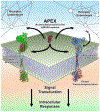The APEX Approaches: A Unified LRR-RK Network Revealed
- PMID: 29602571
- PMCID: PMC6217801
- DOI: 10.1016/j.tplants.2018.03.008
The APEX Approaches: A Unified LRR-RK Network Revealed
Abstract
Leucine-rich repeat receptor kinases (LRR-RKs) represent a large and functionally diverse family of transmembrane proteins critical for signal recognition and transduction at the plant cell plasma membrane. Here, we discuss a recent report which used a systems-level approach to validate key paradigms by constructing an LRR-RK interaction network model.
Published by Elsevier Ltd.
Figures

Comment on
-
An extracellular network of Arabidopsis leucine-rich repeat receptor kinases.Nature. 2018 Jan 18;553(7688):342-346. doi: 10.1038/nature25184. Epub 2018 Jan 10. Nature. 2018. PMID: 29320478 Free PMC article.
Similar articles
-
An extracellular network of Arabidopsis leucine-rich repeat receptor kinases.Nature. 2018 Jan 18;553(7688):342-346. doi: 10.1038/nature25184. Epub 2018 Jan 10. Nature. 2018. PMID: 29320478 Free PMC article.
-
Leucine-rich repeat receptor kinases in plants: structure, function, and signal transduction pathways.Int Rev Cytol. 2004;234:1-46. doi: 10.1016/S0074-7696(04)34001-5. Int Rev Cytol. 2004. PMID: 15066372 Review.
-
Biochemical mapping of a ligand-binding domain within Arabidopsis BAM1 reveals diversified ligand recognition mechanisms of plant LRR-RKs.Plant J. 2012 Jun;70(5):845-54. doi: 10.1111/j.1365-313X.2012.04934.x. Epub 2012 Mar 31. Plant J. 2012. PMID: 22321211
-
Deciphering the complex roles of leucine-rich repeat receptor kinases (LRR-RKs) in plant signal transduction.Plant Sci. 2025 Jul;356:112494. doi: 10.1016/j.plantsci.2025.112494. Epub 2025 Apr 1. Plant Sci. 2025. PMID: 40180130 Review.
-
Plant Leucine-Rich Repeat Receptor Kinase (LRR-RK): Structure, Ligand Perception, and Activation Mechanism.Molecules. 2019 Aug 25;24(17):3081. doi: 10.3390/molecules24173081. Molecules. 2019. PMID: 31450667 Free PMC article. Review.
Cited by
-
Interactive Gene Expression Patterns of Susceptible and Resistant Lens ervoides Recombinant Inbred Lines and the Necrotroph Ascochyta lentis.Front Microbiol. 2020 Jun 24;11:1259. doi: 10.3389/fmicb.2020.01259. eCollection 2020. Front Microbiol. 2020. PMID: 32670221 Free PMC article.
References
-
- Hohmann U et al. (2017) The structural basis of ligand perception and signal activation by receptor kinases. Annual review of plant biology 68, 109–137. - PubMed
Publication types
MeSH terms
Substances
Grants and funding
LinkOut - more resources
Full Text Sources
Other Literature Sources
Miscellaneous

